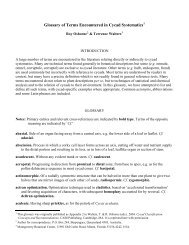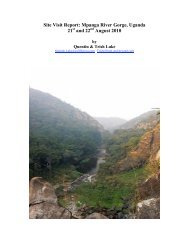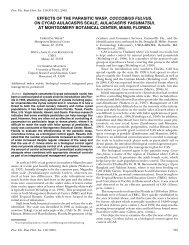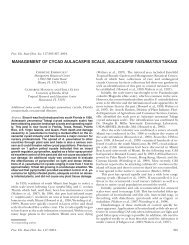Cycas-circinalis-cas.. - Cycad Specialist Group
Cycas-circinalis-cas.. - Cycad Specialist Group
Cycas-circinalis-cas.. - Cycad Specialist Group
Create successful ePaper yourself
Turn your PDF publications into a flip-book with our unique Google optimized e-Paper software.
In total, 150 <strong>Cy<strong>cas</strong></strong> <strong>circinalis</strong> individuals, including 179 stems were monitored across the<br />
15 plots.<br />
Table 4. Number of C. <strong>circinalis</strong> study plots established per location and types of<br />
harvest to which they are subjected<br />
State Location No. of populations<br />
monitored<br />
Harvest Type<br />
Tamil Nadu Gudagur 1 Fruit & leaf<br />
Tamil Nadu Kallar 1 Fruit, leaf & stem<br />
Tamil Nadu Kudkmedu 2 Fruit, leaf & stem<br />
Tamil Nadu Marikode 1 Fruit, leaf & stem<br />
Tamil Nadu Thattekaru 3 Fruit, leaf & stem<br />
Tamil Nadu Vellericombei 3 Fruit & leaf<br />
Kerala Appankapu 1 Fruit only<br />
Kerala Punjakoli 1 Fruit only<br />
Kerala Vaniampuzha 2 Fruit only<br />
4.4.1 Rates of harvest<br />
The surveys illustrated very high levels of leaf-harvest at the individual level<br />
(proportion of leaves harvested per individual) and at the population level (proportion of<br />
individuals harvested per populations). At the time of the surveys, two of the regions<br />
sampled (Marikode and Vellericombei) had been harvested for their most recent whorl of<br />
leaves, and therefore rates and patterns of leaf removal were calculated for these regions<br />
only. The other areas sampled are also harvested for their leaves consistently but did not<br />
have the most recent whorl harvested.<br />
Ninety-two percent of all C. <strong>circinalis</strong> individuals > 20 cm height (those that have<br />
a visible stem) were harvested for their leaves. Only the smallest and the very largest<br />
individuals appear to have escaped harvest (Fig 4). All individuals in the 20-200 cm<br />
range were harvested. Some of the very largest individuals likely escape harvest as it is<br />
very difficult to access their high leaves.<br />
For those individuals that were harvested, an average of 91.3 ± 15 % of all leaves<br />
were removed. Only those leaves damaged by insects were left. The consistent harvest of<br />
such a high proportion of leaves per individual may be expected to decrease the<br />
photosynthetic capacity of the harvested individuals. This in turn could result in<br />
decreased number of leaves produced per whorl; and/or decreased leaf size; and/or<br />
decreased rates of reproduction. Our data did not yield conclusive results with respect to<br />
the number of leaves produced per whorl in harvested versus non harvested plants,<br />
because the data collected did not distinguish the presence of dead leaves versus leaves<br />
from previous whorls. Therefore this as well as leaf length and reproductive output will<br />
be assessed with the next set of monitoring data.<br />
15






